The new Raw Defaults interface in Adobe Camera Raw (ACR) provide a much easier and more intuitive way to assign and manage the default rendering of your raw files across multiple camera models. For example, you may want to change the default rendering setting (such as apply a custom camera profile, change the amount of sharpening, or enable lens profile corrections), on all of the images that you import from one camera model, but not from another. The new Raw Defaults enables you to set custom defaults instead of having to first import files and then change settings. Note: Raw defaults are also applied when/if an image is reset if the image is already in your catalog.
In ACR, click the Preferences (gear) icon.
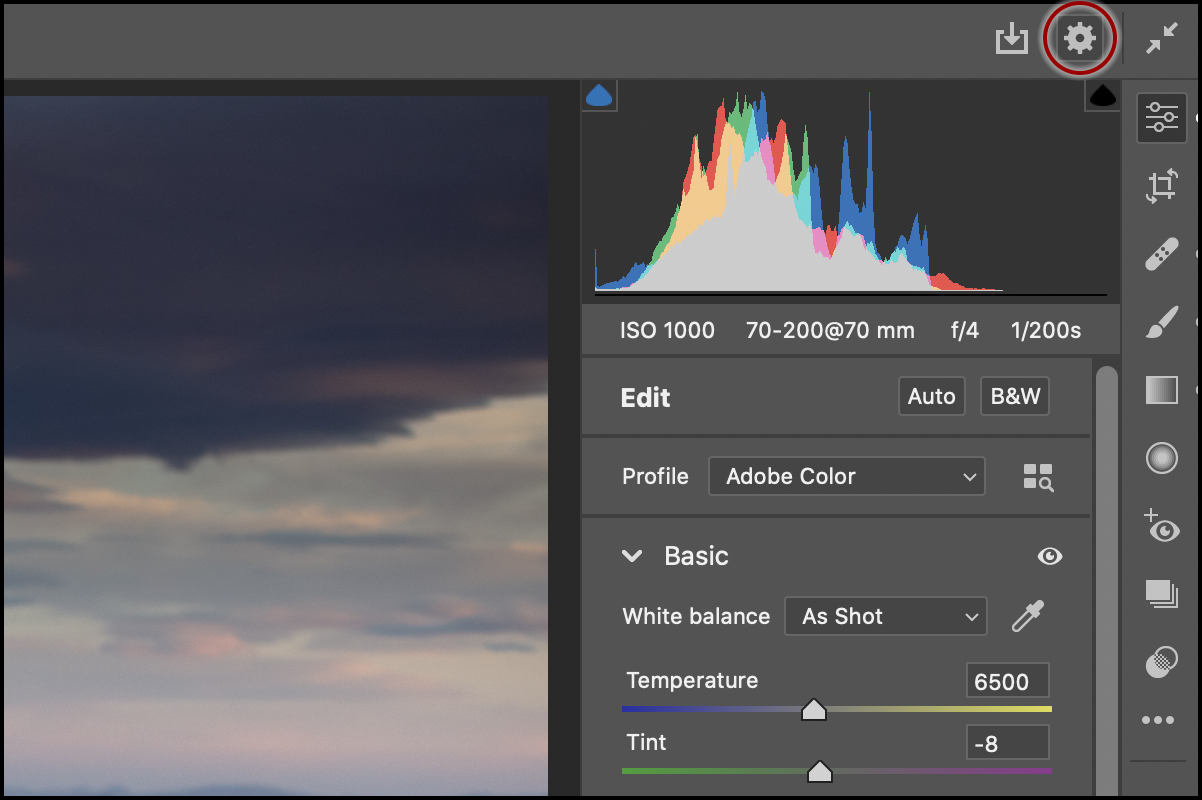
Raw Defaults can be applied universally (across all cameras), or customized by camera model, ISO speed, and even serial number. To apply the same Raw Defaults universally, use the Master drop-down menu and select either Camera Settings or Choose Preset.

• Select Camera Settings to honor picture styles or profiles settings that you’ve set in-camera and preserve the “as shot” look whenever possible (Creative Styles for Sony, Picture Styles for Canon, Film Simulations for Fuji, or Picture Controls for Nikon).
• Select Choose Preset to apply a preset as your Raw Default settings.You can apply one of ACR’s Default presets or create your own (ACR v12.3 installs nine different combinations of Profiles/Lens Correction/Noise Reduction options which can be applied as Raw Default settings in a Preset group called Defaults). If you want to create and use your own preset(s), you will need to first create the preset, then select the Camera Raw Preferences > Raw Default in order to apply it. To create a preset, see “How to Create a Preset in ACR” and “Creating and Working with ISO-Adaptive Presets in ACR” below.
• To return to the ACR’s default settings, choose Adobe Default.
To set different Raw Defaults for each camera model, enable “Override master setting for specific cameras” and select the desired camera from the Camera drop-down menu.

Use the drop-down menu to select either Camera Settings or Choose Preset. ACR v12.3 installs nine different combinations of Profiles/Lens Correction/Noise Reduction options which can be applied as Raw Default settings in a Preset group called Defaults. In the example below I have selected a preset from the Defaults group that applies the Adobe Landscape profile, Lens Corrections, and variable Noise Reduction settings.
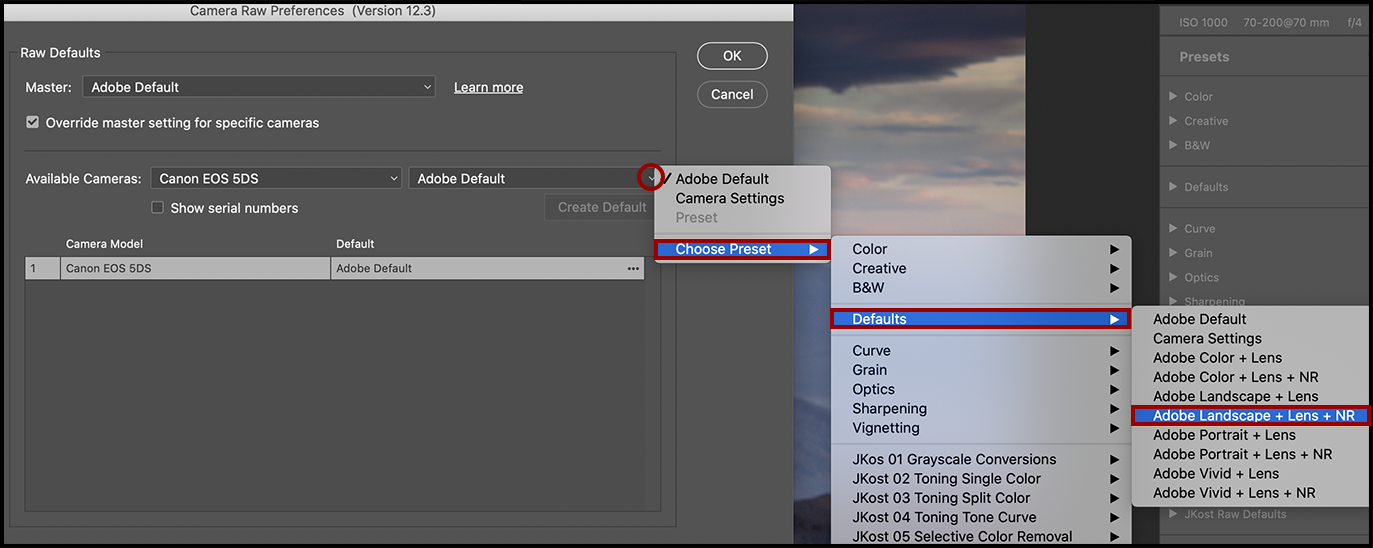
ACR displays the Camera Model and the Default settings making it easy to keep track of the settings applied to different cameras. To reset, change, or delete a Raw Default setting, click the more icon (the three dots) to the right of the camera model/default and select the desired option.
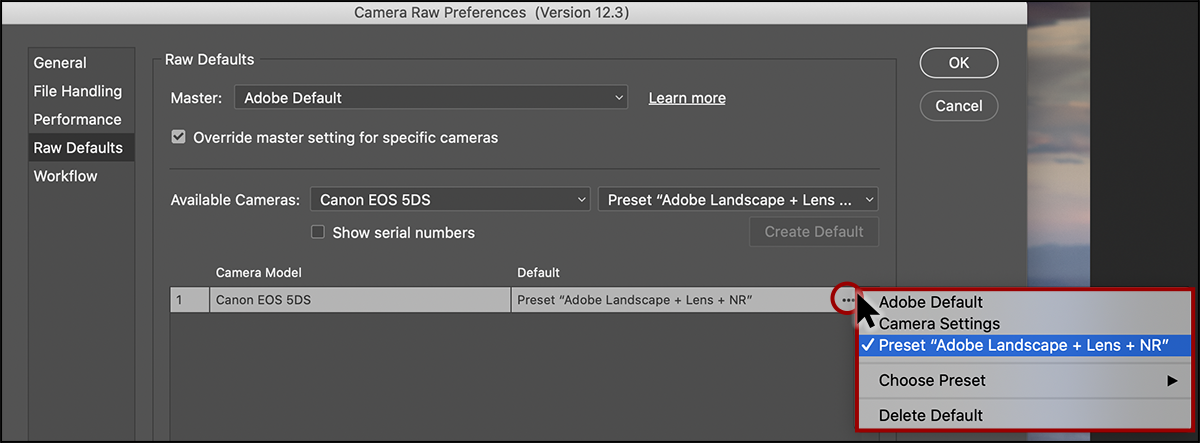
Once Raw Defaults are set, all newly opened raw files (and raw files that are reset in ACR) will be rendered using the Raw Defaults. To customize the defaults for multiple cameras of the same model, enable “Show serial numbers”.

How to Create a Preset in ACR
With the new group of Default presets, many photographers will not need to create their own custom Raw Defaults presets. If, however, you have a different combination of edits that you prefer to apply as Raw Defaults, here’s how to create a preset:
• First, make the changes to the photo that you want to include in the preset. In the example below, I’ve changed the Profile to Adobe Landscape, enabled Remove Chromatic Aberration and Use Profile Corrections, and slightly increased the amount of Texture, Clarity, and Vibrance.
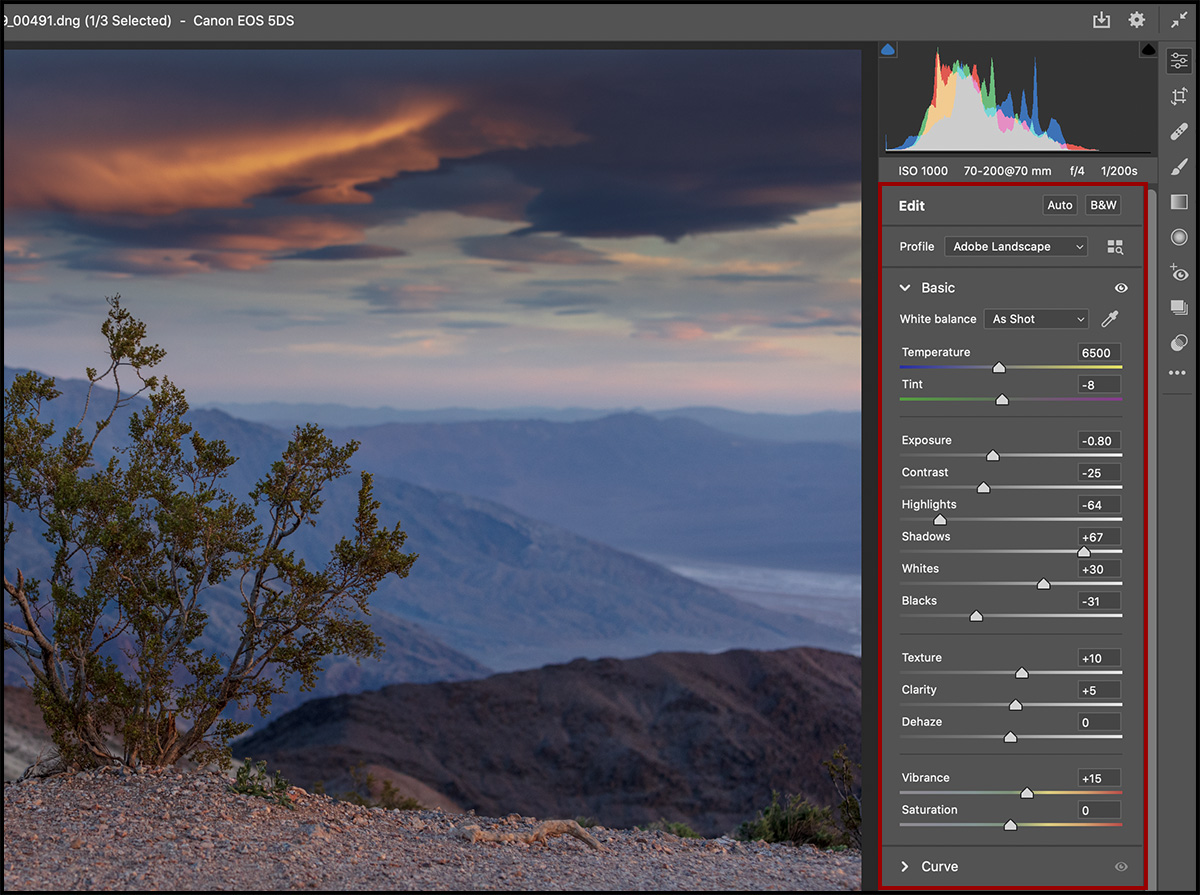
• Click the Preset panel icon and click to add a New Preset.
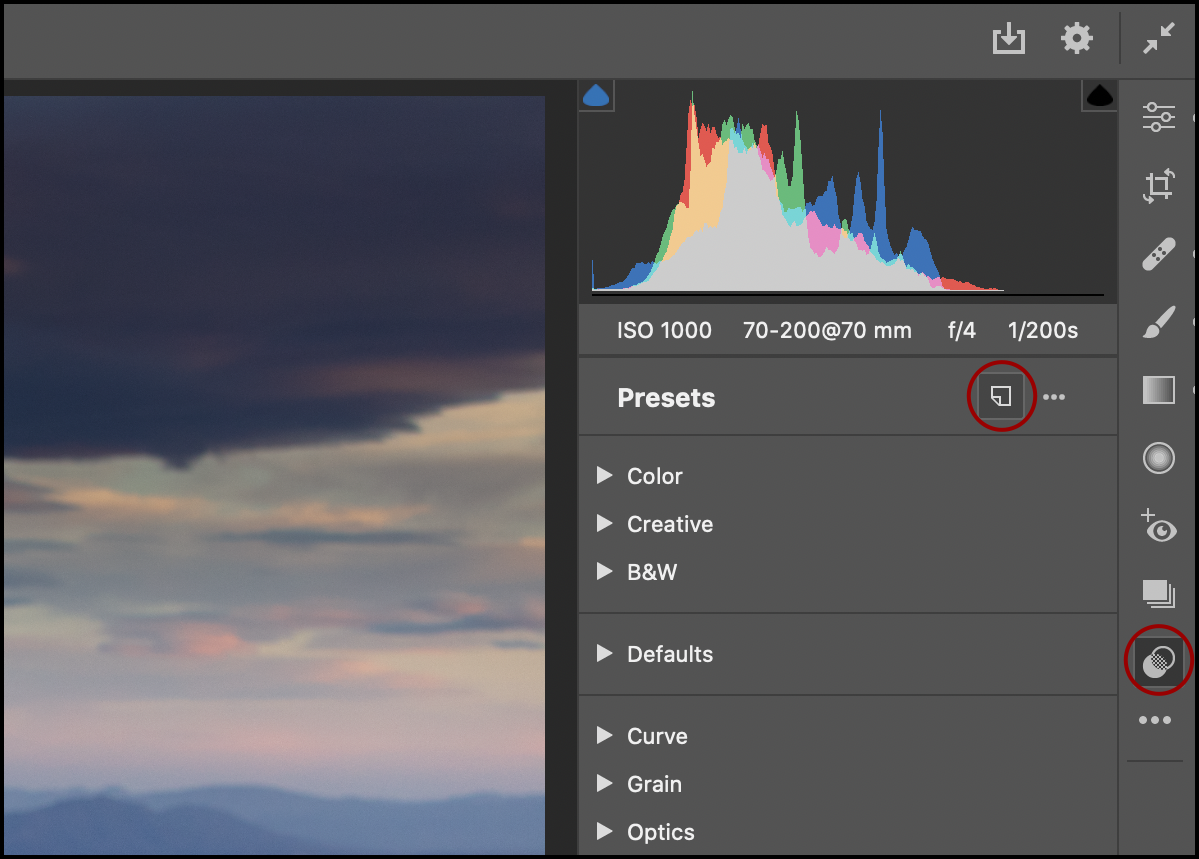
• Name the Preset, select a Group, enable (check) the settings that you want to be saved as a part of the preset, and click OK to create the preset.

Creating ISO Adaptive Presets in ACR
In ACR v12.3, you can create ISO Adaptive presets which allow a single preset to apply different edit settings to different photos depending on their ISO settings. For example, you can create an ISO Adaptive preset that applies different levels of noise reduction or sharpening to “high” ISO verses “low” ISO images. With ISO Adaptive presets, you need only to assign the values to two or more images from the same camera (those values will then be used to interpolate the correct settings based on the actual image’s ISO).
ACR installs four presets in the Default Group which include ISO Adaptive Noise Reduction settings that are specifically designed to be applied as Raw Defaults:
Adobe Color + Lens + NR
Adobe Landscape + Lens + NR
Adobe Portrait + Lens + NR
Adobe Vivid + Lens + NR
If the default presets don’t meet your needs, here’s how to create your own ISO Adaptive Preset:
• Select two or more images, with different ISO values that were taken with the same camera.

Left image ISO = 400, Right image ISO = 1000.
• Edit the setting for the images as desired.

In this example, Noise Reduction (Luminance) was increased slightly for the 400 ISO image (left), while both Noise Reduction (Luminance) and Color Noise Reduction were increased for the 1000 ISO image (right).
• With the images still selected, click the Preset icon to display the Preset panel, then click the New Preset icon.

• In the New Preset dialog, enable (check) the desired settings to include in the preset and be sure to enable “Create ISO adaptive preset” in the “ISO Settings” area. Note: If two or more images, with different ISO values, are not selected, “Create ISO adaptive preset” will be disabled. As ISO Adaptive presets aren’t visually different, you may want to include ISO as part of the name or place the ISO Adaptive presets in their own preset group.
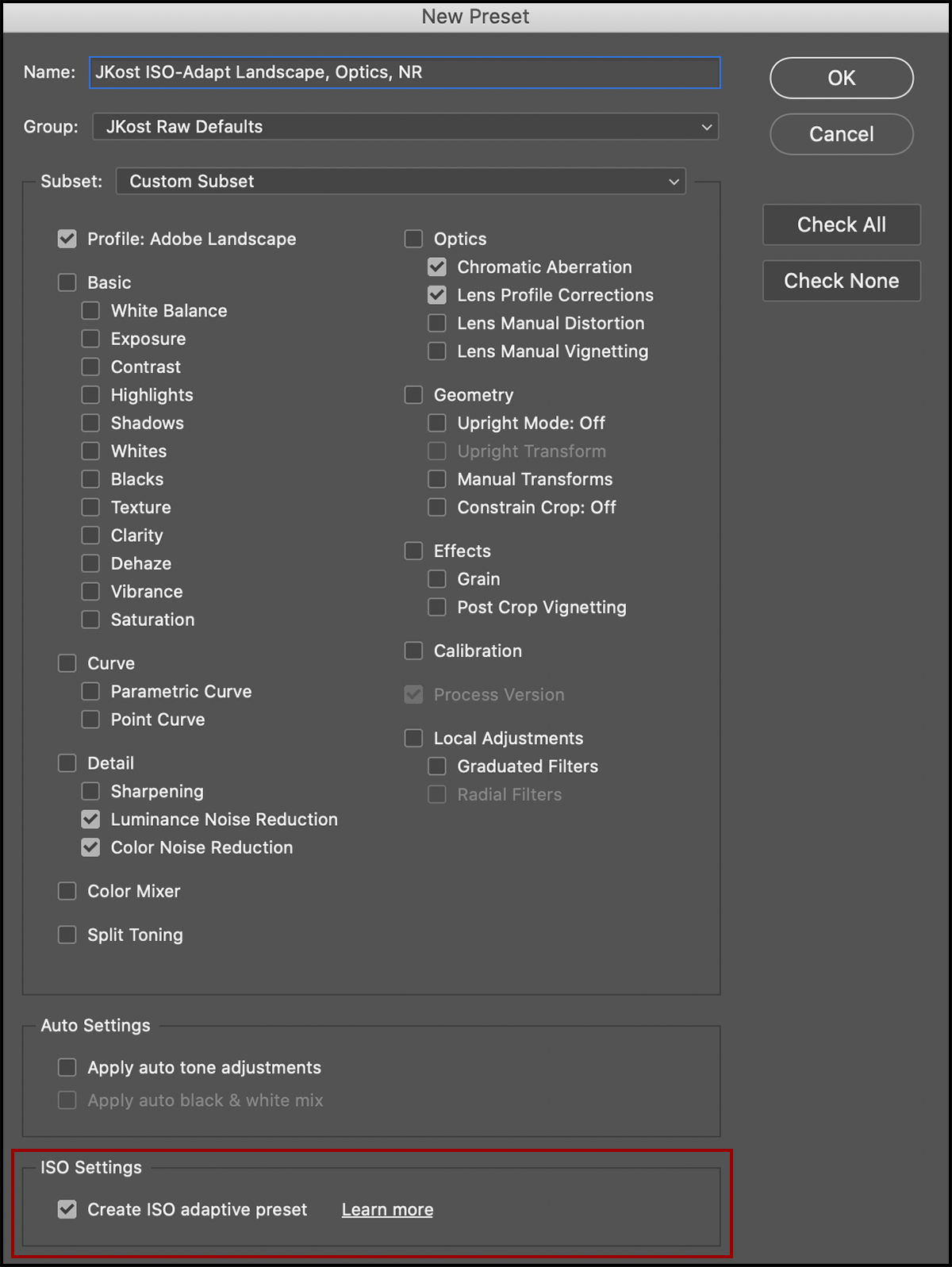
• Click “OK” to create an ISO Adaptive preset. When applying the preset, ACR will automatically interpolate the correct amount of noise for images with different ISO values.
Click here for more information on Raw Defaults from the ACR team.
Hello,
Where is the straighten tool now in ACR 12.3 and now if I zoom in it zoomsto 200% or nothing where as before i clicked on my mouse and it was gradual..which i so much prefered..
Thanks
Russell
The straighten tool is nested with the Crop Tool.
Use the zoom popup menu and select 100% for the default “zoom” (or whatever zoom you prefer). And here are some additional ways to zoom:
Command + 0 (Mac) | Control + 0 (Win) will fit the image within the preview area (Fit In View).
Option + Command + “0” (Mac) | Alt + Control + “0” (Win) sets the view to 100%.
Command + “+” (plus) (Mac) | Control + “+” (plus) (Win) zooms in.
Command + “-” (minus) (Mac) | Control + “-” (minus) (Win) zooms out.
Command -drag (Mac) | Control -drag (Win) to zoom into a specific area.
Click -drag left/right to zoom out/in with the Zoom tool (Scrubby Zoom).